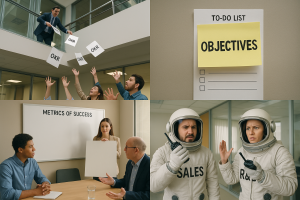
OKRs and Complexity
Let’s see… who hasn’t experienced the scene of the team that has a list of objectives longer than a grocery ticket for the family’s weekly shopping, but has no idea where to start?

Spoiler: that’s not alignment. It’s a recipe for mass confusion.
And yes, misunderstood OKRs can become bureaucracy disguised as good intentions. We’ve seen it. Many times.
We live in a complex world, where changes are not only rapid, but also unpredictable. Teams that yesterday were launching an MVP, today are putting out fires and tomorrow… who knows?
In this context, a key question arises:
How to align equipment without losing agility or killing autonomy?
OKRs (Objectives and Key Results) have gained fame as a star tool for achieving strategic alignment in agile environments. But if misused, they can become a gilded cage. Nice, yes, but a cage nonetheless.
This article is not just another tutorial on how to write “pretty” OKRs. For that there is already this article. It is an invitation to rethink how to use this tool in complex environments, without losing the most valuable thing that agile teams have: their ability to adapt, learn and move forward.
Complexity ≠ Complication
Important: complex is not the same as complicated.
A complicated system (such as an airplane) can be decomposed and replicated by following instructions. A complex system (like an agile team in a VUCA environment) cannot. There the variables are interrelated and constantly changing.

So if you treat OKRs as if they were IKEA instructions, the result can be disastrous. In complex environments, we need clear direction (compass), not absolute control (GPS).
In complex environments, the approach cannot be 100% predictive or based on cascades alone. We need dynamic alignment, not rigid structures.
Complexity requires humility: accepting that we don’t have all the answers and that OKRs must be born out of conversations, not impositions. In other words: it’s not just a matter of having well-written objectives, but how those objectives are adapted, inspected and adjusted as the environment changes.
OKRs in complex systems = compass
OKRs in complicated systems = map
What else do you need now?
OKRs in complex environments: heroes or villains?
OKRs have a superpower: they can align an entire organization toward a shared purpose.

But they also have their kryptonite: poorly designed or poorly managed, they can generate more chaos than clarity.
In complex environments, where solutions are not obvious and paths are not mapped out, OKRs must become living conversations, not strategic tombstones.
Where do they usually fail?
Common anti-patterns we have observed in organizational transformation processes:

- Cascading OKRs without dialog: those at the top define, those at the bottom translate. Result: loss of meaning.
- Objectives that look like tasks: “Review the quality process” is not an objective, it is a checklist item. If it smells like a task, it is a task, don’t be fooled.
- Key Results that are empty metrics: numbers without context, which are reported but not transformed.
- The same OKRs for all teams: as if the sales team and the R&D team lived on the same planet.
In complex environments, adaptability is everything. And OKRs must reflect that. It’s not about setting them in January and praying until December. It’s about learning, inspecting and adapting.
Real-world example: At a tech startup, OKRs were quarterly but reviewed monthly. The focus? Impact, not completeness. The result: focus + flexibility – and yes, this can be your team too!
Strategic alignment without killing agility
How do we get everyone rowing in the same direction without putting each team in a different gondola or chaining them to the rudder?
First, remember: to align is not to control.

To align is to create a shared purpose that is clear enough for teams to move autonomously within limits.
Good practices with OKRs:
Adaptive cadences according to the pace and maturity of the team.
Real conversations: more than writing, talk about the “what for”.
Emerging OKRs: let them also be born from the teams.
Coherence, not replication between organizational levels.
A well-designed OKR opens doors, not closes them. And an agile system needs just that: doors open to learning, not locked corridors.
And what do the leaders have to do with all this?
A lot.
If OKRs are the conversations that align, leaders are the ones who must facilitate them. Not impose them.

Agile leadership involves moving from “I tell you what to do” to “I create the space where we can figure it out together”. In the context of OKRs, this means:
- Ask “what impact do we want to generate?” before “what are we going to do?”.
- Accompany in prioritization and clarity, without micromanaging.
- Be willing to redefine a goal if learning demands it (no drama!).
In addition, leaders must be able to adapt their style according to the maturity of the team. A forming team probably needs more guidance. A performing team, more autonomy. To expect everyone to work with OKRs as if they were the same is to ignore organizational diversity.
In short: OKRs don’t scale themselves. They scale with conscious, present and adaptive leadership.
OKRs don’t scale themselves. They scale with conscious, present and adaptive leadership.
From theory to clay: tools that help
Deming already said it:
“Without data, you’re just another person with an opinion.”
But without reflection, data is just noise.
Useful tools:
Alignment check-in (monthly): check which OKRs are still alive.
- What OKR do we feel is guiding us?
- Which KRs no longer make sense?
- What is emerging that we should consider?
OKR Canvas: visual template for building and adjusting objectives.

OKR Canvas Dependency mapping: to align OKRs between teams, visualize cross OKRs between teams to detect blockages, overlaps and synergies.
Impact stories: qualitative, making sense of the results to see how progress is being made towards the objective.
These tools are not magic. But they help you do something that is: think together, act together, and learn in the process.
OKRs as compass, not as GPS
In complex environments, pretending to predict the exact path is naïve.
But that doesn’t mean walking blind. It means we need compasses, not GPS. Clear directions, not fixed routes.
That’s what OKRs are for: to align without suffocating, to focus without constraining, to guide without controlling. In the end, they are an excuse (a good excuse) to talk about what is important: purpose, impact, meaning.
So the next time you sit down to define OKRs with your team, don’t start with the numbers. Start with the questions:
- What change do we want to see in the system?
- What results will tell us that we are going in the right direction?
- How willing are we to learn, unlearn and adapt?
Because OKRs are not the end. They are a means to something much more valuable: an organization where every team knows where it’s going… and feels part of the journey.

My Final Opinion on OKRs
OKRs can be the red thread that connects purpose, strategy and action. But only if we treat them as a living thing, not just another Excel in the cloud.
If you find that your teams are caught between complexity and excessive metrics, maybe it’s time to rethink the way you apply OKRs.
And if you want someone to help you get it right, you know that Smartway is here for you.
Interested in implementing OKRs without killing agility? Find out more about our OKR consulting for enterprises. Subscribe to our newsletter The Smart Drop and receive weekly practical ideas to lead the change.


